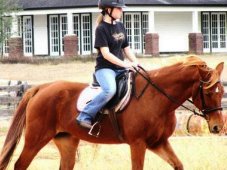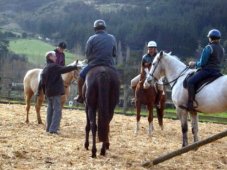Is It My Fault – Or My Horse’s?

Without "being there" and observing the interaction, the only thing we can say for sure is that the communication between you and your horse failed. Why it failed is a more complicated issue that frustrates multitudes of riders daily. You are not alone.
Communication can fail because of rider error. It can fail because the horse is not sufficiently far along in its training to understand the shape that the rider’s aids suggest. It can fail because the horse is physically unable to take the shape because of conformation faults, old injuries, lingering soreness from yesterday’s workout, or equipment that restricts or interferes with the shape. It can fail because the horse is mentally burned out. Or the communication can fail because the horse simply has the kind of personality that says that day, "I don’t want to," or "You can’t make me" or "You didn’t ask the right way so I’m going to ignore that.
You need to examine your particular communication failure from all of those different perspectives in order to figure out why things didn’t go according to your plan. The first thing to ask yourself is whether the horse is capable of understanding your request. Where is he in his training? Is this something he’s just learned or a movement he’s been doing for some time?
Next, ask yourself a few questions about the horse’s body condition. Is this a new horse that might be happier with a different saddle or bit than the ones you have chosen? Could the horse be a little sore from strenuous work his last time out? Are you asking for a movement that might be difficult for this horse given his current level of physical conditioning or his conformation?
Think about the horse’s mental condition. Having you been drilling this or similar movements a great deal recently? Have you just returned from a stressful show or other event? Or has he been confined for several days without any opportunity to play a little before working?
Be honest about your riding skills. Is the movement you asked for something that is relatively new in your riding experience? Is this a movement that other riders can get from this horse easily? Are you completely relaxed, balanced and following the motion of the horse as you apply your aids? Are you applying the correct aids in a coordinated way with the right timing and right degree of pressure?
When you put the answers to all of these questions together, what you need to do next will be much clearer. For example, if the horse is green, he may just need more quiet repetitions of exactly the same aids applied in the same rhythm with exactly the same timing and degree of pressure until the light bulb goes off in his head that this particular set of pressures goes away when he takes the right shape. Until that happens, the rider may be doing everything correctly but the results of the communication will be uneven.
This scenario assumes, of course, that the rider has an independent seat and can apply aids in a way that influences the horse. If not, then there’s the root of the problem. She needs to keep on practicing, using the horse’s response as feedback that helps her learn when she’s got it right. Until the rider gets better, there will be many more times ahead when the communication is less than perfect. That’s alright. Work with a good instructor who can help you through the rough spots as you develop the independent seat you need for clear communication.
If the horse is an old campaigner who absolutely knows what piaffe means or how to do a perfect rollback, then the rider needs to ask if the horse may be hurting physically or a burned out mentally. If the horse is sore or sour, then they should do something else that day until those problems are resolved. If those aren’t issues, then the rider needs to consider the horse’s personality. Is this an animal that sometimes has an attitude or that looks for ways to evade its work? Then you may need to repeat your request, reinforcing it by using a greater degree of the pressures you know the horse understands or even enforcing the aids with the spur or crop.
Depending on your own personality, your first reaction to a communication breakdown may be to blame yourself for being inept or stupid. Or you blame the horse for being stubborn or grouchy. Or you blame the instructor for putting you on a second-rate school horse that’s not much fun to ride. Assigning blame does not fix a problem. Instead, look at the communications failure as an opportunity. The best way to improve your riding is to learn from your mistakes. Just keep riding.



